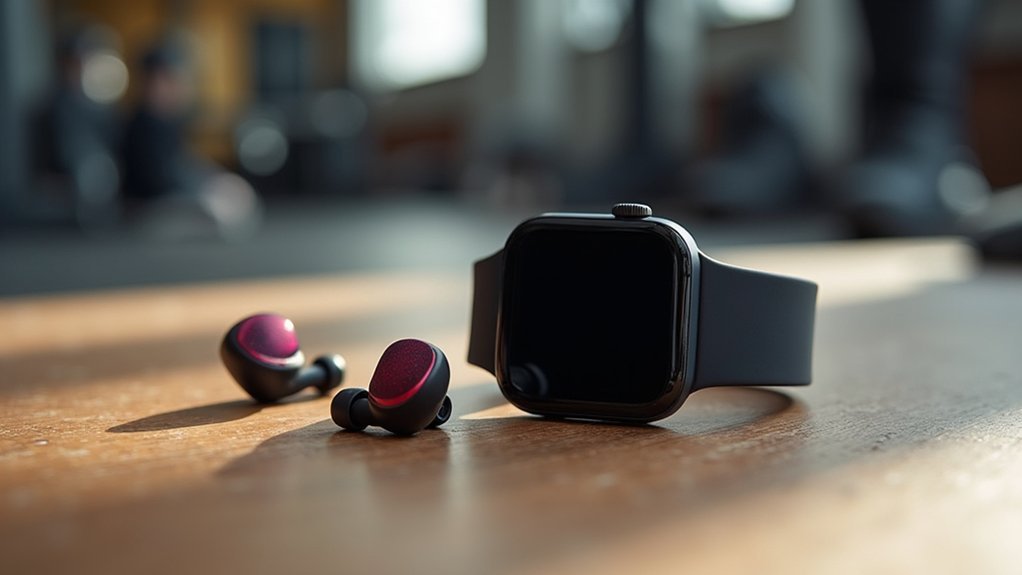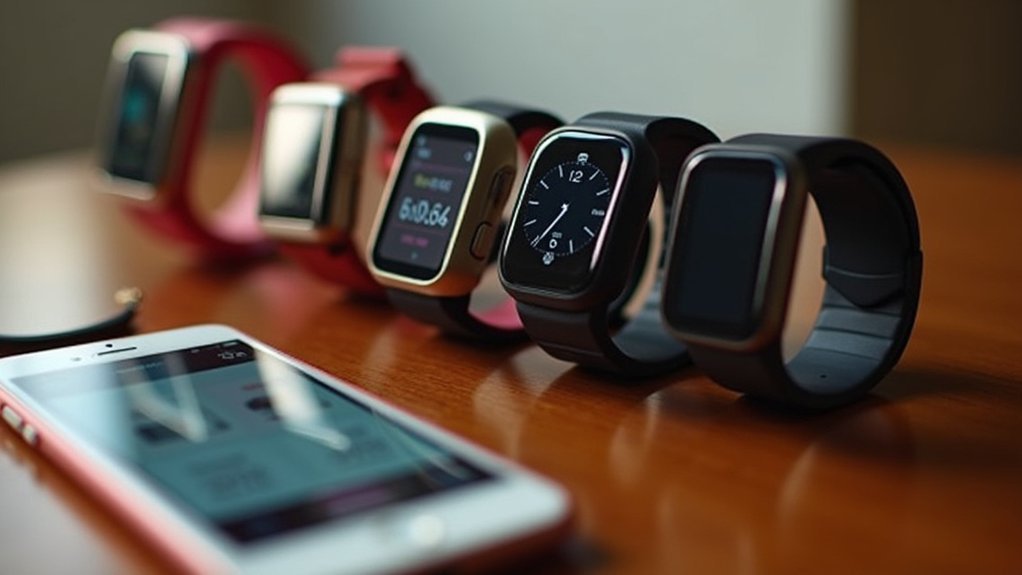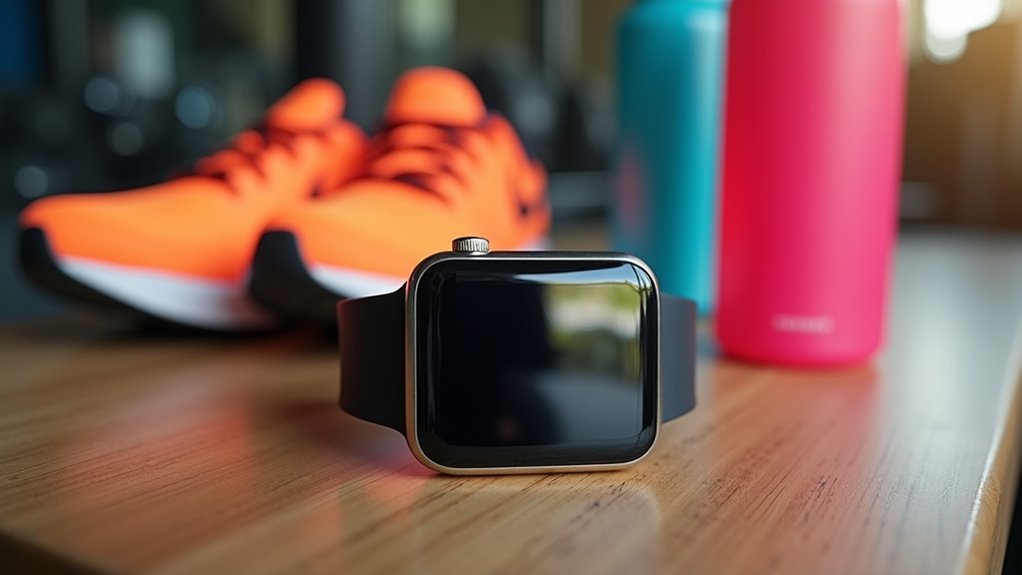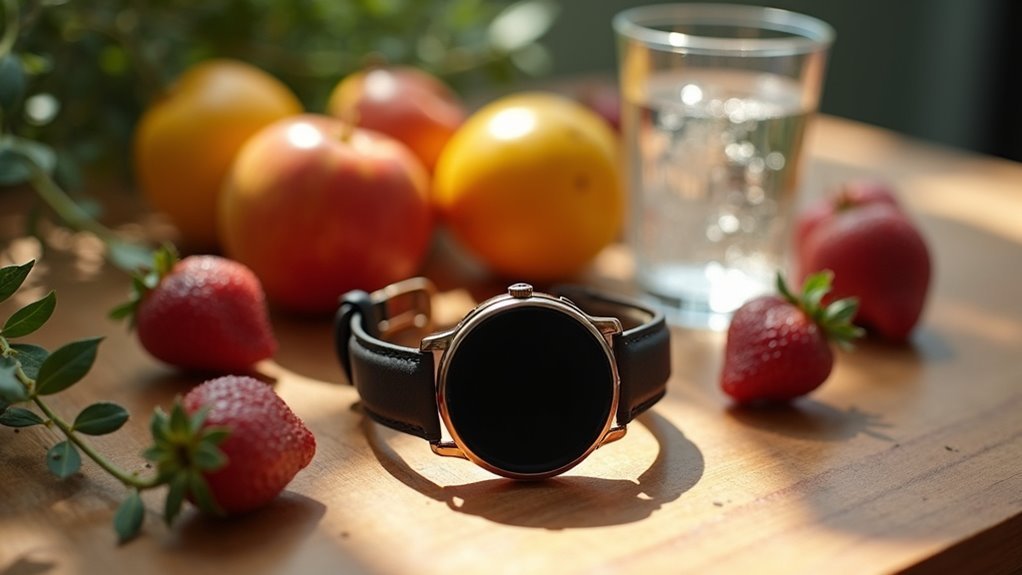You can choose fitness watches with substantial onboard storage like the Garmin Forerunner 965 (4-32GB) or Apple Watch Ultra 2 (64GB) to store hundreds of songs directly on your wrist. Budget models typically offer 4GB for MP3 playback, while premium options hold 500-650 songs offline. You’ll transfer music via USB or desktop apps, eliminating monthly streaming fees. Battery life drops to one-third during playbook, but downloaded music performs better than streaming. Continue exploring to discover ideal models and setup strategies.
Top Features That Enable Music Storage and Playback

Modern fitness watches transform your workout experience by storing hundreds of songs directly on your wrist.
Fitness watches revolutionize workouts by putting your entire music library right on your wrist for seamless, phone-free exercise sessions.
You’ll find most popular models offer offline storage for 500 to 650 songs, while budget devices typically include 4GB dedicated music memory for MP4 playbook. Higher-end models provide expandable storage options for extensive playlists.
You can sync music directly from streaming apps like Spotify, Deezer, and Amazon Music, enabling offline playback without your smartphone.
Bluetooth audio support connects wirelessly to your headphones, while some models feature built-in speakers for hands-free listening.
Intuitive touchscreen interfaces let you manage playlists effortlessly, with customizable widgets and quick-access buttons. Top brands like Garmin, COROS, Suunto, Polar, and Fitbit lead the market with over 50 tested devices for performance and functionality.
You’ll control playback directly from your watch face, using wrist gestures for pause, skip, and volume adjustments.
Best Fitness Watch Models for Offline Music Storage
When choosing a fitness watch for offline music storage, you’ll need to compare storage capacities across different models to guarantee they meet your playlist needs.
You should also understand the various file transfer methods available, from computer syncing to direct downloads through companion apps. The Garmin Forerunner 265 offers music storage capabilities in both its standard and S models, making it a solid choice for runners who want their playlists readily available.
Additionally, checking compatible audio formats is essential since not all watches support every file type you might want to store.
Storage Capacity Comparison
Three major fitness watch categories dominate the offline music storage landscape, each offering distinct advantages for users who want to leave their phones behind during workouts.
Premium sports watches like the Garmin Forerunner 965 lead with 4-32GB total storage, providing approximately 4GB for your music and apps. You’ll get substantial space for hundreds of songs without compromising device performance.
Mid-range options like COROS watches offer varying storage capacity depending on the model, though they typically provide less than Garmin’s flagship devices. The exact specifications aren’t consistently documented across their lineup.
Apple Watch Ultra 2 dominates with up to 64GB internal storage, but you’re limited to Apple Music subscriptions or purchased tracks. The device features a titanium case construction that makes it lighter than many competing sports watches despite its premium materials.
Budget fitness bands and low-end trackers offer no onboard music storage whatsoever.
File Transfer Methods
Once you’ve identified a fitness watch with adequate storage capacity, getting your music files onto the device becomes the next challenge.
Most fitness watches support direct USB connection, allowing you to drag-and-drop audio files into the watch’s music folder. Some brands provide dedicated desktop apps that manage music transfers and playlist syncing more efficiently.
Higher-end models offer mobile app syncing via Bluetooth or Wi-Fi, eliminating the need for cables. Cloud-based transfers are available on select watches by linking streaming service accounts. However, brand-specific limitations exist.
Garmin and Coros models typically support straightforward USB transfers, while Apple Watch requires syncing through your paired iPhone. Fitbit has discontinued direct music uploads, and budget models like some Amazfit watches don’t support offline music storage at all. Users experiencing music storage deactivation with Pandora and Deezer services should be aware that these offline features were removed by the end of March 2023.
Compatible Audio Formats
Understanding which audio formats your fitness watch supports determines whether you can load your existing music library or need to convert files before transfer.
Most fitness watches accept MP3 and AAC formats, which cover the majority of personal music collections. You’ll find that Garmin watches work well with MP3 files, while Apple Watches primarily use AAC format through iTunes or Apple Music.
However, you won’t get support for high-resolution formats like FLAC on mainstream fitness watches due to storage and battery constraints. The limited codec options focus on standard formats for compatibility and efficiency.
If you’re using streaming services like Spotify or Deezer, the watch handles format compatibility automatically when downloading playlists, making the process seamless regardless of the original file type. Some models like the Garmin Forerunner 245 Music can store up to 500 songs for extensive offline listening during workouts.
Free Music Streaming Services Compatible With Fitness Watches
You’ll find that free music streaming services offer varying levels of compatibility with fitness watches, though each comes with distinct limitations.
Spotify’s free tier restricts you to shuffle play and includes ads, while Amazon Music Lite provides a streamlined experience with basic functionality.
YouTube Music’s compatibility depends on your watch’s operating system and may require workarounds to access free content during workouts. Most fitness watches work with specific platforms, requiring careful consideration of your smartphone’s operating system before making a purchase decision.
Spotify Free Tier Limitations
While Spotify’s free tier gives you access to the same massive music library as Premium subscribers, several key limitations can impact your fitness watch experience.
You’ll encounter shuffle-only playback on mobile devices, meaning you can’t select specific songs during workouts. The six-skip-per-hour restriction limits your ability to find the perfect workout track quickly.
Audio quality drops to 160 kbit/s on mobile and 128 kbit/s on desktop, which may affect sound clarity through your fitness watch’s speakers or connected headphones.
You’ll also deal with ads interrupting your workout flow between tracks. These interruptions occur approximately every 15 minutes and can last around 30 seconds each.
Most importantly, you can’t download music for offline listening, requiring a constant internet connection. This limitation proves challenging during outdoor activities where cellular connectivity might be weak or unavailable.
Amazon Music Lite Features
Amazon Music Lite offers a streamlined alternative that addresses many of Spotify’s free tier drawbacks for fitness watch users.
You’ll find this lightweight version designed specifically for low data usage and efficient performance on devices with limited hardware resources.
With compatible Garmin watches, you can sync playlists directly through the Connect IQ Store and enjoy offline playback without needing your phone during workouts.
The app prioritizes essential music features and easy navigation during fitness activities, offering basic controls like play, pause, skip, and volume adjustment directly from your wrist.
You’ll access a large catalog with free streaming, though premium content requires Amazon Prime or Music Unlimited subscriptions. Keep in mind that each playlist can hold a maximum of 150 songs when stored on your watch.
The optimized design minimizes battery impact while integrating seamlessly with your watch’s health tracking functions.
YouTube Music Compatibility
YouTube Music has expanded its reach into the fitness watch ecosystem, with Garmin leading the charge by offering dedicated app support through their Connect IQ store. You’ll need a YouTube Music subscription to download songs and podcasts directly to compatible Garmin models like the Fenix 7, Venu 3, and Forerunner 265 Music.
| Feature | Details |
|---|---|
| Offline Playbook | Download playlists to watch storage |
| Setup Process | Sign in via smartphone with code entry |
| Storage Access | Over 100 million songs and podcasts |
| Audio Requirements | Bluetooth headphones necessary |
After syncing your playlists, you can enjoy music during workouts without your phone connected. This integration positions Garmin as one of few brands supporting multiple streaming services, though you’ll still need that paid subscription for full functionality. Unlike some streaming services that offer remote control capabilities with free accounts, YouTube Music requires a subscription for any smartwatch functionality.
How to Transfer and Sync Music Files to Your Watch
Once you’ve chosen a fitness watch with music capabilities, you’ll need to understand the transfer process since each brand uses different methods.
Wear OS watches typically use Bluetooth file transfer apps to move music from your smartphone. For Amazfit watches, you’ll move music to a specific folder on your phone, then upload it through the official Amazfit app.
Samsung watches offer multiple options, supporting both direct playback and streaming services like Spotify.
Most watches support common formats like MP3, WAV, and AAC. You can transfer files via USB cable, Wi-Fi, or Bluetooth connectivity. Keep in mind that battery consumption increases when playing music directly from the watch.
Before starting, organize your music in a dedicated folder on your computer or phone. Use file browser apps to select and send files, then verify the transferred music is accessible on your watch.
Battery Life Performance During Music Playback and Workouts

After successfully loading your music files onto your fitness watch, you’ll want to understand how music playbook affects your device’s battery performance during workouts.
Playing music greatly reduces battery life, with most watches lasting only a third of their normal time during continuous playback.
Music playback drastically cuts fitness watch battery life to roughly one-third of normal duration during continuous use.
Key factors that impact your battery during music-powered workouts include:
- GPS + Music combo drains fastest – Expect around 8-13 hours from top models like Garmin Fēnix 8 when using both features simultaneously.
- Audio quality settings matter – Higher bitrates like Spotify’s “very high” quality increase power consumption considerably.
- Display brightness affects duration – Dimming your screen and disabling always-on mode extends workout time significantly.
You’ll get better battery performance using downloaded music rather than streaming, though both options still demand substantial power during intense training sessions. The Garmin Vivoactive 4 provides 18 hours in GPS mode without music, demonstrating the significant battery impact when audio features are disabled.
Bluetooth Connectivity and Wireless Headphone Compatibility
Getting your fitness watch to work seamlessly with wireless headphones requires understanding Bluetooth connectivity basics and compatibility requirements. Most fitness watches support Bluetooth 5.0 or higher, providing reliable connections with wireless headphones and speakers. You’ll find standard compatibility across Garmin, Fitbit, Amazfit, and Samsung Galaxy Watch series.
| Feature | Performance |
|---|---|
| Connection Range | 10-30 meters typical |
| Audio Codecs | SBC standard, AAC/aptX on premium models |
| Pairing Limit | One audio device simultaneously |
| Stability | Stable during vigorous activity |
| Reconnection | Automatic with saved profiles |
To pair headphones, activate pairing mode, access your watch’s Bluetooth settings, and select your device. Most watches save headphone profiles for quick reconnection. If you experience connection issues, restart both devices and verify firmware updates are current for peak compatibility. Modern fitness watches enable you to enjoy music during workouts while simultaneously monitoring your heart rate and tracking your steps.
Price Comparison of Music-Enabled Fitness Watches

Music-enabled fitness watches span a wide price spectrum, from budget-friendly options under $100 to premium models exceeding $400. Your choice depends on the features you prioritize and your budget constraints.
Several key factors influence pricing in music-enabled fitness watches:
Understanding these pricing factors helps you identify which features justify higher costs and find the best value for your specific fitness and music needs.
- Storage capacity – Models like the Garmin Venu 2 offer storage for 650 songs, while budget options provide basic music control without local storage.
- Premium features – Advanced GPS tracking, high-resolution displays, and extensive health monitoring drive up costs considerably.
- Brand reputation – Established brands like Apple and Garmin command higher prices due to their software ecosystems and reliability.
You’ll find excellent value in mid-range options like the Amazfit GTR 4, while the Apple Watch Series 5’s refurbished models offer premium features at accessible prices. The Samsung Galaxy Watch 5 provides 16 GB of storage for music, making it a competitive option for those prioritizing local music storage capacity.
Music Control Features and User Interface Design
Seamless control transforms a fitness watch from a simple timepiece into your personal DJ during workouts.
You’ll find intuitive interfaces with clear icons and responsive touchscreens that make managing music effortless during intense activities. AMOLED displays guarantee you can see playlist options even in bright sunlight, while physical buttons and rotating bezels offer tactile alternatives when touchscreen use isn’t practical.
You can customize watch faces with music shortcuts for instant access to play, pause, skip, and volume controls.
Voice assistants like Alexa enable hands-free operation when you’re mid-rep. The best designs integrate music controls directly with fitness metrics screens, so you won’t need to constantly switch between apps while tracking your workout progress. The Amazfit Active stands out with offline music storage that can hold over 30,000 songs directly on your wrist.
Frequently Asked Questions
Can I Use My Fitness Watch’s Music Features While Swimming or in Water?
You can’t reliably use your fitness watch’s music features while swimming. Bluetooth connections fail underwater, and prolonged water exposure during music playback risks damaging your device, even with water resistance ratings.
Do Fitness Watches With Music Storage Work Without Any Smartphone Connection?
You can play stored music on your fitness watch without any smartphone connection. Downloaded songs, podcasts, and playlists work independently through Bluetooth headphones, requiring no Wi-Fi or cellular data during playback.
How Much Internal Storage Space Do I Need for My Music Collection?
You’ll need 2-4 GB for basic workout playlists, storing roughly 500-1,000 songs. If you’re an advanced athlete wanting diverse music libraries for longer training sessions, consider 4-8 GB storage capacity instead.
Will Using Music Features Void My Fitness Watch Warranty or Damage It?
Using music features won’t void your fitness watch warranty or damage it. These features are designed for normal use and covered under manufacturer guidelines. Only unauthorized repairs or physical damage typically affect warranty coverage.
Can I Share Stored Music From My Watch With Other Devices Wirelessly?
You can’t share stored music wirelessly from your fitness watch to other devices. Most watches only support Bluetooth audio output to headphones, not file transfers to phones or computers.
In Summary
You’ll find that music-enabled fitness watches transform your workout experience by eliminating the need to carry your phone. Whether you’re choosing offline storage or streaming services, prioritize battery life and Bluetooth connectivity. Don’t overlook user interface design—you’ll want easy music controls during intense sessions. Compare prices carefully, as features vary considerably between models. With the right watch, you’ll enjoy seamless music playback that keeps you motivated throughout every workout.





Leave a Reply